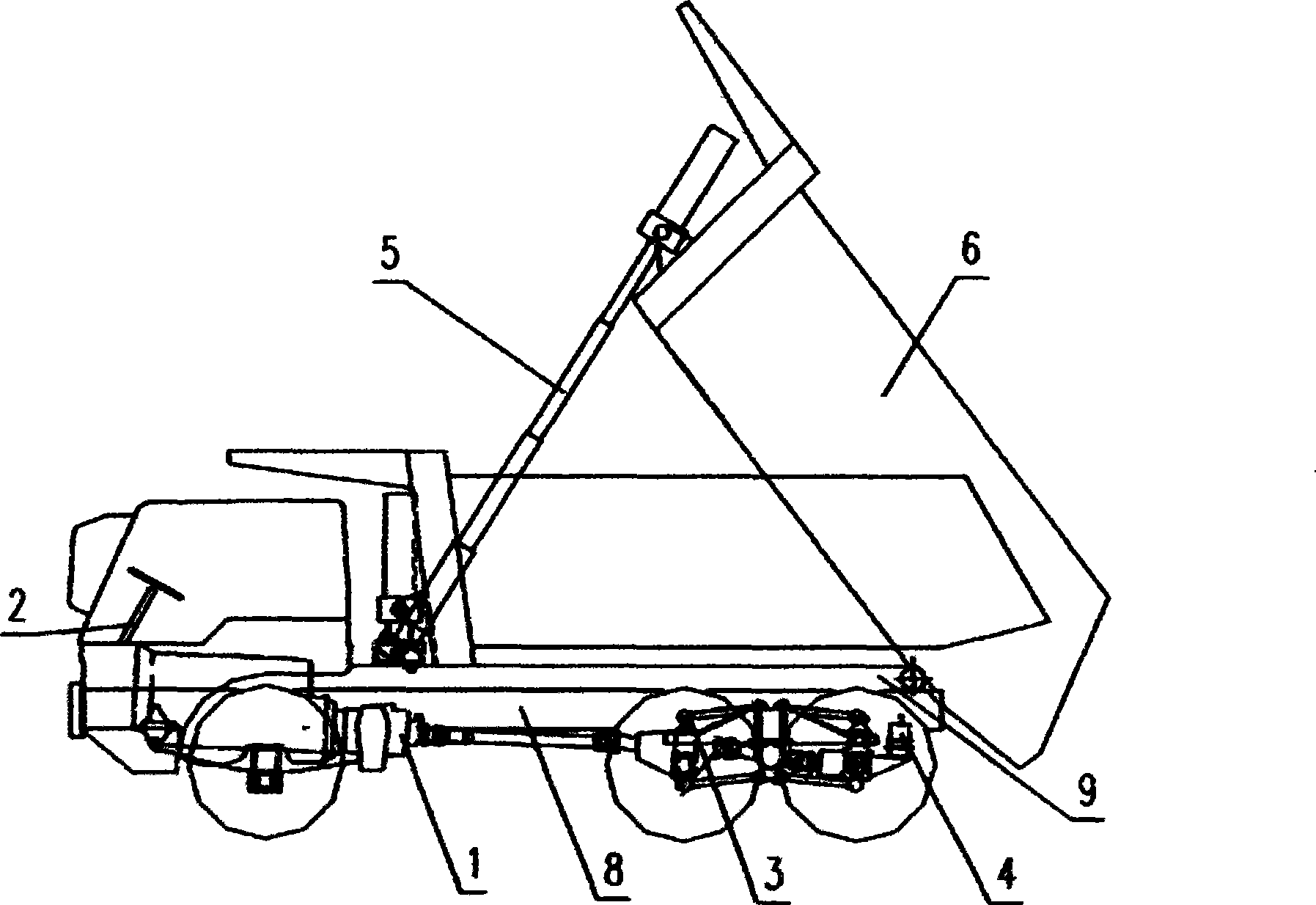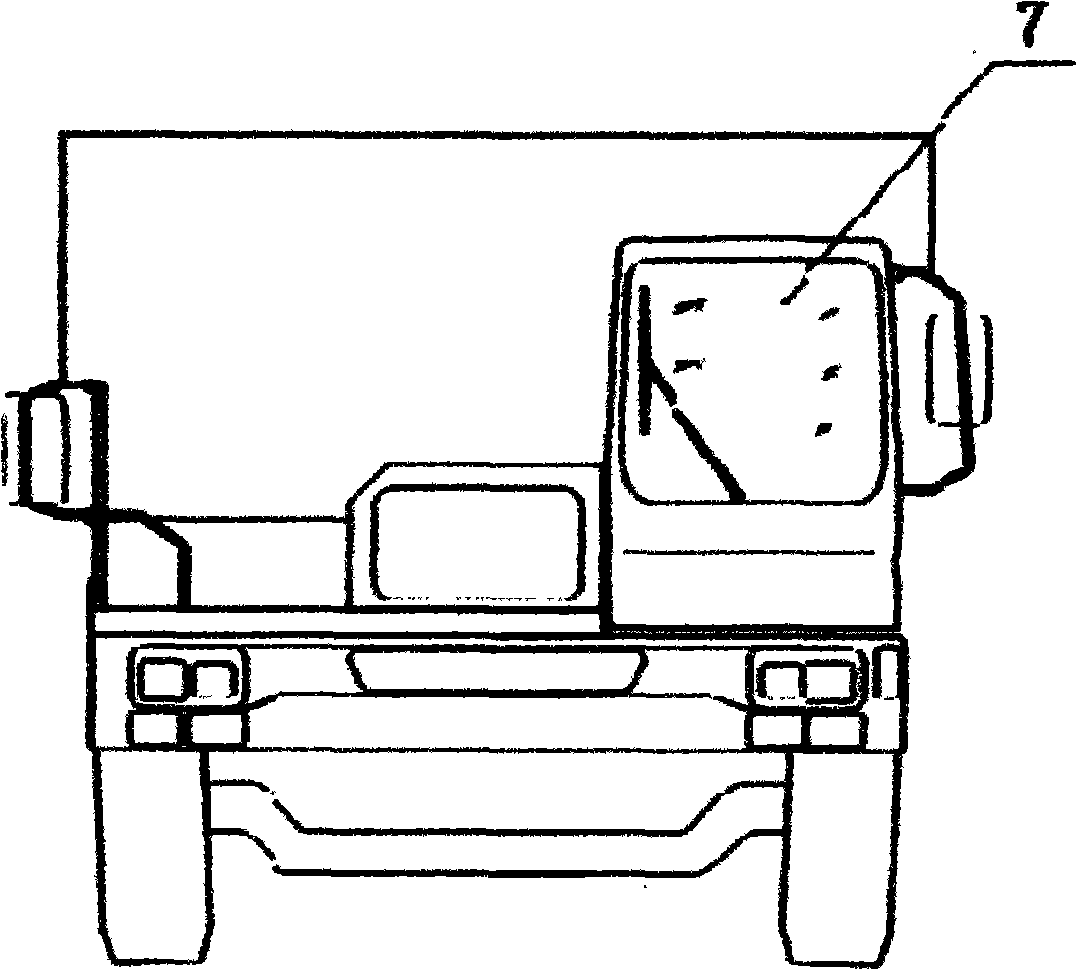Design method for off-highway self-discharging vehicle
A design method and technology for dump trucks, which are applied to vehicle components, vehicles with inclined bearing motion, elastic suspensions, etc., can solve the problems of large axle jump, reduce the service life of oil cylinders, and high noise, and achieve good driving performance. , Improve the bearing capacity and the effect of riding comfort
- Summary
- Abstract
- Description
- Claims
- Application Information
AI Technical Summary
Problems solved by technology
Method used
Image
Examples
Embodiment 1
[0084] Example 1 as figure 1 with figure 2 As shown, this non-highway dump truck includes a car body, a frame, a power system, a transmission system, a carriage, tires, and a braking system. Its power system 1 is connected to the main frame 8, and the steering system 2 is connected to On the left front outside of the main frame 8, the suspension system 3 is connected below the main frame 8, the brake system 4 is connected to the inside and outside of the main frame 8, and the hydraulic cylinder of the lifting system 5 is connected to the On the front end of the subframe 9 and on the front plate of the cargo box 6, the cargo box 6 is connected to the subframe 9, the subframe 9 is connected to the main frame 8 through a bracket and a connecting plate, and the driver's cab 7 is connected to the main frame 8 through a bracket. Front left of the main frame.
[0085] It is aimed at the special working conditions of the construction site. Its power system matching design adopts a ...
Embodiment 2
[0097] Embodiment 2 is basically the same as Embodiment 1, and the difference is that its suspension is a balance beam suspension such as diagram 2-1 As shown, there are four rubber main springs 2-1 in total, two of which are connected to the two ends of the equalizing beam 2-4 on the left side of the vehicle frame 2-23 by bolts 2-2, and the other two are connected by bolts 2-2 to the The two ends of the equalizing beam 2-4 on the right side of the vehicle frame 2-23, and the bottom of the four rubber main springs 2-1 are respectively connected to the axle housing processing surfaces of the middle axle 2-18 and the rear axle 2-10 through bolts 2-11 The middle part of the balance beam 2-4 is connected to the two ends of the balance shaft 2-16 with rubber bearing 2-19, rubber bearing cover 2-20, and bolt 2-21, and the balance shaft 2-16 is fixed on the balance shaft support 2-14 Among them, the two balance shaft brackets 2-14 are respectively connected to the vehicle frame 2-23...
Embodiment 3
[0098]Embodiment 3 is basically the same as Embodiment 1, and the difference is that its suspension is another kind of suspension structure such as Figure 3-1 As shown, it is the longitudinal distribution diagram of embodiment 3, the upper thrust rod 3-1 and the lower thrust rod 3-13, the middle bridge 3-14 and the support 3-11, and the four balance beams 3-15 pass through the upper thrust rod beam end The connection of support 3-2, upper thrust rod bridge end support 3-4 and lower thrust rod support 3-9 forms two side-by-side four-bar linkages at the front end and rear end of four balance beams 3-15, which can effectively control Longitudinal runout of middle axle 3-14 and rear axle 3-16. The two ends of the four upper thrust rods 3-1 are respectively connected to the upper thrust rod beam end support 3-2 and the upper thrust rod bridge end support 3-4 by two bolts 3-17, and the upper thrust rod beam end support 3-2 is single The limit is connected on four beams 3-15 and th...
PUM
| Property | Measurement | Unit |
|---|---|---|
| Width | aaaaa | aaaaa |
Abstract
Description
Claims
Application Information
 Login to View More
Login to View More - R&D
- Intellectual Property
- Life Sciences
- Materials
- Tech Scout
- Unparalleled Data Quality
- Higher Quality Content
- 60% Fewer Hallucinations
Browse by: Latest US Patents, China's latest patents, Technical Efficacy Thesaurus, Application Domain, Technology Topic, Popular Technical Reports.
© 2025 PatSnap. All rights reserved.Legal|Privacy policy|Modern Slavery Act Transparency Statement|Sitemap|About US| Contact US: help@patsnap.com



